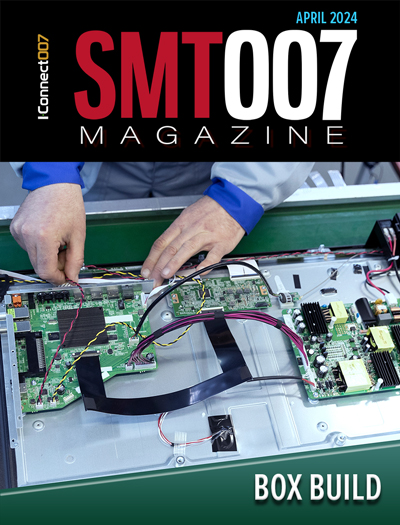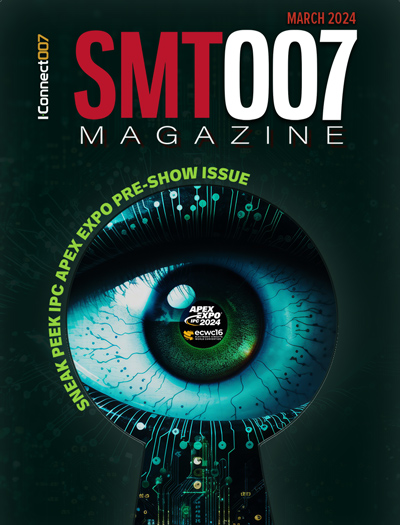-

- News
- Books
Featured Books
- smt007 Magazine
Latest Issues
Current Issue
Box Build
One trend is to add box build and final assembly to your product offering. In this issue, we explore the opportunities and risks of adding system assembly to your service portfolio.

IPC APEX EXPO 2024 Pre-show
This month’s issue devotes its pages to a comprehensive preview of the IPC APEX EXPO 2024 event. Whether your role is technical or business, if you're new-to-the-industry or seasoned veteran, you'll find value throughout this program.

Boost Your Sales
Every part of your business can be evaluated as a process, including your sales funnel. Optimizing your selling process requires a coordinated effort between marketing and sales. In this issue, industry experts in marketing and sales offer their best advice on how to boost your sales efforts.
- Articles
- Columns
Search Console
- Links
- Events
||| MENU - smt007 Magazine
Clean vs. No-clean: A Generational Difference
December 24, 2019 | Barry Matties, I-Connect007Estimated reading time: 1 minute
Tom Forsythe, executive VP of KYZEN, discusses what readers should know about cleaning as reliability expectations continue to increase. He also explains what is driving the new interest in cleaning and why engineers from the no-clean generation may not even realize they need to learn more about cleaning.
Barry Matties: Tom, why don’t you start by telling us about your new generation of stencil and misprinted board cleaner.
Tom Forsythe: Absolutely. KYZEN E5631 has been under development for some time. The whole challenge for us, of course, is that contaminants, fluxes, and pastes are constantly evolving. Many leading solder makers around the world are trying to improve their performance because our mutual customers are demanding improved performance from them. It trickles down to the cleaning folks to make sure we can remove those residues, whether it’s uncured adhesives, uncured paste in a true stencil printing application, or anything down that road. That’s the key, and it’s an area that we’ve done a lot of research on over the last 5–10 years. It had been stagnant for a long time, but once you crack the egg and start working around, your development leads you in lots of different directions; that’s how 5631 came to be.
Matties: Is this driven by the finer features that are appearing?
Forsythe: The finer features drive back to the stencils. The companies making the stencils have issues because they have to make apertures that are smaller and closer together and more well-defined. As those apertures get smaller, then it becomes a bit more difficult to get things out of those smaller apertures and have flow go through them. It all cascades. But it fundamentally comes down to the materials. The bigger driver on the stencil side is the new materials. Remember, when you reflow paste, lots of volatiles come off. It goes through a state change and creates that hard encapsulant.
To read this entire interview, which appeared in the December 2019 issue of SMT007 Magazine, click here.
Suggested Items
Taiyo Circuit Automation Installs New DP3500 into Fuba Printed Circuits, Tunisia
04/25/2024 | Taiyo Circuit AutomationTaiyo Circuit Automation is proud to be partnered with Fuba Printed Circuits, Tunisia part of the OneTech Group of companies, a leading printed circuit board manufacturer based out of Bizerte, Tunisia, on their first installation of Taiyo Circuit Automation DP3500 coater.
Vicor Power Orders Hentec Industries/RPS Automation Pulsar Solderability Testing System
04/24/2024 | Hentec Industries/RPS AutomationHentec Industries/RPS Automation, a leading manufacturer of selective soldering, lead tinning and solderability test equipment, is pleased to announce that Vicor Power has finalized the purchase of a Pulsar solderability testing system.
AIM Solder’s Dillon Zhu to Present on Ultraminiature Soldering at SMTA China East
04/22/2024 | AIMAIM Solder, a leading global manufacturer of solder assembly materials for the electronics industry, is pleased to announce that Dillon Zhu will present on the topic: Ultraminiature Soldering: Techniques, Technologies, and Standards at SMTA China East. This event is being held at the Shanghai World Expo Exhibition & Convention Center from April 24-25.
AIM to Highlight NC259FPA Ultrafine No Clean Solder Paste at SMTA Wisconsin Expo & Tech Forum
04/18/2024 | AIMAIM Solder, a leading global manufacturer of solder assembly materials for the electronics industry, is pleased to announce its participation in the upcoming SMTA Wisconsin Expo & Tech Forum taking place on May 7 at the Four Points by Sheraton | Milwaukee Airport, in Milwaukee, Wisconsin.
Hentec/RPS Publishes an Essential Guide to Selective Soldering Processing Tech Paper
04/17/2024 | Hentec Industries/RPS AutomationHentec Industries/RPS Automation, a leading manufacturer of selective soldering, lead tinning and solderability test equipment, announces that it has published a technical paper describing the critical process parameters that need to be optimized to ensure optimal results and guarantee the utmost in end-product quality.


